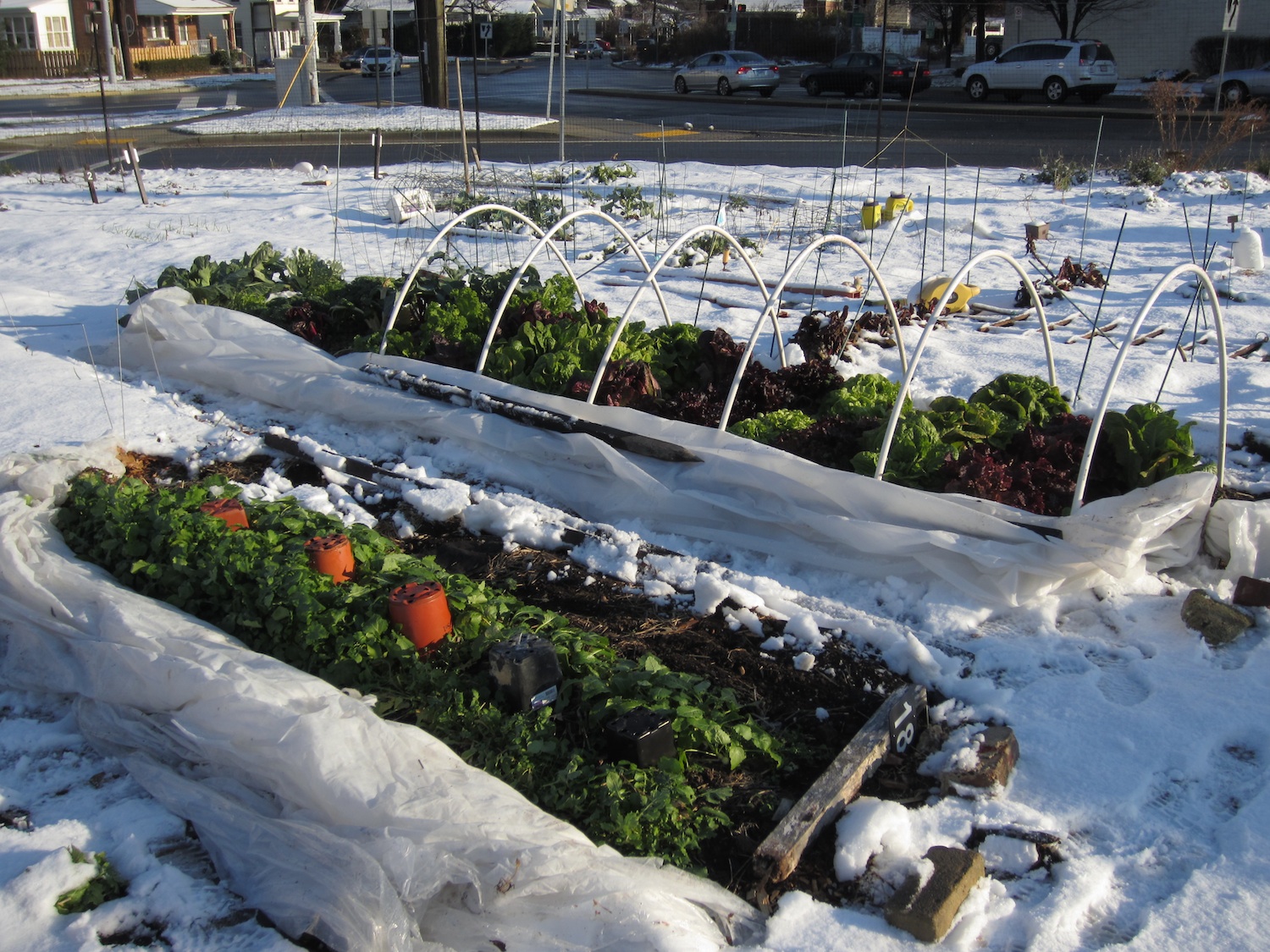
When we think of eating homegrown food during the cold season, we often think of staples such as potatoes squirreled away in the root cellar, or of vegetables such as winter squash stashed in a cool, dry place. But many gardeners are discovering the joys of harvesting fresh produce all winter long, which allows for feasts of cold-hardy crops that are just-picked and just right for the time of year. According to Jodi Lew-Smith of High Mowing Seeds in Wolcott, Vt., the seed-buying season used to be January, February and March. “Now there’s also a surge in June, July, August and into September for fall-planted crops,” she says. Eating from the garden is just too pleasant to give up simply because the temperature — and the snow — may have fallen.
I don’t mean growing tomatoes in January. Fruiting crops no doubt need long, sunny days and warm conditions to complete their delicious arc of softening, deepening in color and perfectly ripening. Winter fare is about leaves, stems and roots, which mature more and more slowly as the weather cools and the days shorten. Better still, winter vegetables sweeten with the cold. If you’ve ever tasted a winter-pulled carrot or winter-cut spinach, you’re familiar with the treasures winter gardening can bring.
With my husband, Eliot Coleman, I run Four Season Farm in Harborside, Maine, where winter production is a key part of our business. Over the past two decades, we’ve built, trialed and collected data on many hoop house designs and crop-protection methods. We’ve also tested many crops — and multiple varieties of those crops — to discover what grows best in winter.

Climate Considerations
So, should a winter gardener grow different crops depending on her climate? Not necessarily. Winter has always been a good season for a wide array of crops in the southern states, and in the northern tier of the United States, you can grow the same crops if you use a winter-protection device to broaden your garden’s productive season. This might be a cold frame, a simple greenhouse, the quick-hoop system, or just a layer or two of floating row cover, often called Reemay. All of these season-extension devices capture some of the earth’s natural warmth, especially at night, and block the chilling, drying effect of wind.
At any latitude in the United States, there’s enough daylight to grow a wide range of winter crops. A recent MOTHER EARTH NEWS survey on winter gardening turned up a surprising number of cold-season gardeners in places where weather would present a challenge, such as Ontario and Wisconsin, as well as many in unsurprising locales, such as Texas and Southern California, where an outdoor garden can keep on truckin’ with a simple shift of the planting scheme . While in the Northeast we think of the year’s “second spring” starting around August, warmer southern areas can shift that date by a couple of months to around October, when fall temperatures will still be high enough to achieve germination and allow plants to reach maturity.
Winter growing has taken off in the commercial sphere, too, which helps farmers with short growing seasons make a living year-round. But home gardeners have an advantage: They don’t have to produce uniform, cosmetically perfect vegetables on any set schedule for a competitive market. In short, home gardeners can better roll with winter’s punches than large-scale producers can. Home-scale winter growers can experiment with the timing of their crops, sowing new ones whenever a space, no matter how small, becomes vacant. They can try lots of varieties until they find the ones that grow best — and taste best — for them. The seven well-tested crops and varieties illustrated here are some of my absolute, tried-and-true favorites.

Leafing Out
When you’re choosing winter crops and their varieties, you’re obviously looking for cold-tolerance, but the plant’s growth habit and schedule should also influence your selection. Spinach, for example, is a hardy winter annual, which means that it germinates in fall, grows during late fall and winter, and then goes to seed in spring. Because it continually puts out new leaves, you can pick it all winter. Cold-hardy Brussels sprouts and broccoli, on the other hand, stop producing after a certain point (although their leaves are a tasty bonus you shouldn’t miss). Here are some of the best leafy winter crops to try.
Spinach. This crop wins my personal gold medal in the winter leaf-crop category. Sown in late summer, it survives our coastal Maine winter in an unheated greenhouse, under just a layer of row cover. The increasing day length in spring is the major factor in spinach bolting (going to seed). Of the available varieties, ‘Space’ has done best for us — it’s very hardy and slow to bolt in spring. Lew-Smith’s trials favor ‘Giant Winter’ spinach. Well-known seed breeder John Navazio of the Organic Seed Alliance in Washington likes ‘Winter Bloomsdale,’ and is developing a superior version called ‘Abundant Bloomsdale.’

Lettuce. Although not as frost-tolerant as spinach, lettuce does prefer cool weather and is a great fall and spring crop, even in the coldest climates. Leaf lettuce is hardier than full-head types, especially at “baby leaf” size (closely planted and cut at 3 inches tall), and works great as a crop that can be cut multiple times. Among the cold-hardiest lettuce varieties are ‘Red Oak Leaf’ and romaines such as ‘Winter Density’ and ‘Rouge d’Hiver.’ ‘Five Star’ lettuce mix from Johnny’s Selected Seeds in Maine is mildew-resistant — an important trait if you grow in the wetter, more humid conditions of a greenhouse.
Arugula. Increasingly popular as a cut-and-come-again crop, arugula’s friendly bite adds pizazz to meals on cold days, without the flea beetles, bolting, or harsher flavor that come with growing it in summer. ‘Astro’ is a great performer, and ‘Sylvetta,’ which is perennial as far north as Kansas and Virginia, grows wonderfully at lower temperatures.
Asian greens. At Four Season Farm, we did a trial of every Asian green we could find — mostly brassicas — planted under row covers in a 50-foot, unheated greenhouse. The hardiest was tatsoi, which forms large heads of small, dark green, spoon-shaped, mild-flavored leaves — firm enough for a stir-fry but soft enough for a salad. Tatsoi survives winter by hun kering down, flat on the ground, like a round, green rug. As you harvest the outer leaves, new ones will grow in the center. A strong runner-up was ‘Mei Qing Choi,’ a dwarf bok choy whose upright leaves have crisp, white bottoms. I’m fond of feathery mizuna, pungent and thick-stemmed Chinese mustard, and an apple green, open-headed Chinese cabbage called ‘Tokyo Bekana.’ Impressively, Asian greens tend to be heat-tolerant as well as cold-friendly — they are even usable after they’ve bolted, offering still-tasty foliage, crisp stems and edible flowers.
Chard. Great in any season and more heat-tolerant than lettuce, chard will occasionally survive winter with no protection in my Maine garden, dying back to the ground and regrowing in spring. For winter harvest, we’ve found the most cold-hardy variety to be ‘Argentata.’
Kale. Of the European kales (Brassica oleracea), ‘Winterbor’ is exceptionally vigorous and more cold-resistant — though less tasty — than the deep blue-green Tuscan kales, such as ‘Lacinato.’ ‘Even’ Star Smooth’ kale, hardy to 6 degrees Fahrenheit, is tender and sweet. Hardiest of all are the Siberian types (B. napus), which are tender and have a milder flavor than other kales. Some of these, such as ‘True Siberian’ and ‘Western Front’ from Adaptive Seeds in Oregon, keep producing leaves all winter long.
Mâche. Too delicate to ship and scarce in farmers markets, mâche is the gardener’s reward. A winter annual, it will just sit where it’s planted after sowing until the coolness of fall coaxes it out of the ground. It is among the hardiest of winter greens, but it’s maddeningly slow to grow, with tiny heads best cut whole, at 3 inches across, and no regrowth. You’ll forgive all of that, though, because a salad of mâche is like no other, the slightly cupped leaves seemingly designed to hold a light vinaigrette. ‘Vit’ is an excellent variety for winter growing.
Claytonia. This delightful little plant is an unsung hero of winter gardening. A North American native also known as “miner’s lettuce,” it nourished prospectors during the California gold rush days. The nickel-sized, round, succulent leaves are mild in salads but too fragile for cooking. A winter annual, claytonia regrows speedily after repeated cuts in winter if protected from serious frost, and then bolts in spring in a cloud of tiny, fragrant white flowers.
Parsley. The hardiest of herbs, parsley slows its growth in winter but will sometimes survive without protection — even in Zone 5 — yielding lush, bushy greens in spring before it goes to seed. Many cooks prefer flat-leaf parsley, but curly varieties such as ‘Forest Green’ are more frost-proof. Parsley is a self-seeding biennial, so if you leave it in one spot and don’t disturb the area, you can expect it to resprout or self-sow the following year.

Rooting for Flavor
Even if you grow root crops for storage, you can treat many of them as fresh-harvested winter crops, too. In areas with minimal freezing, you can leave most of your root crops in the ground and simply dig them up as needed. Potatoes aside, this is true even for moderate freezes.
Carrots. I’ve seen carrots survive in Vermont under nothing but a good snow cover, though you shouldn’t depend on that. In coastal Maine, they are foolproof inside a cold frame packed with loose straw or hay, or in an unheated greenhouse beneath a layer of row cover. We make multiple sowings from late July to mid-August, but readers in warmer climates report planting as late as November. (You can plant beets on this same schedule, but they’re not as cold-hardy.) After several good frosts, winter carrots are like candy, as strong flavor compounds have receded to the background, and natural sugars — nature’s antifreeze — have stepped to the fore. Flavor declines when the day length stretches up to 10 hours, usually in late January or in February. For us, the best winter variety is ‘Napoli.’
Turnips. My favorite for winter is ‘Hakurei,’ a white, round Japanese variety. I get sweet, tender roots great for eating raw, and tasty tops if the temperature is kept above freezing. ‘White Egg’ is a popular storage variety in the South, but it can be winter-grown elsewhere. ‘Colletto Viola,’ from Italy, has pink shoulders and sweet, crisp white flesh.
Leeks. Add rich, oniony flavors to your winter salads and soups by including some leeks in your mix of winter crops. This is likely the most universally grown winter crop in European households. Look for one of the winter varieties, of which we prefer ‘Lexton.’ Leeks need to be planted early in spring for harvest in winter.
Radish. This fine crop needs protection from frost but loves cool weather. We’ve succeeded with ‘Tinto’ and ‘D’Avignon,’ a French breakfast type. Navazio recommends ‘Cherry Belle’ for flavor.
Jumping Into Winter Gardening
Winter gardening is surprisingly easy. The pace is slow, weeds are few, and low light levels cut down on evaporation and can even eliminate the need for watering from mid-November to mid-February in most areas of the country. Try lots of crops to see which work best for you. With each, start with the least protection you might need (some crops may surprise you), and then decide how accommodating you’re willing to be. Experiment with timing to find a rhythm that works, putting in new crops wherever you see an empty space. Make lots of compost to give your crops an extra boost. Also, keep in mind that you should fear heat more than cold. Remember to vent cold frames, quick hoops and greenhouses on sunny days, lest you trap hot air inside and then prematurely “cook” your greens.
Keep an eye open for new varietal entries in this ever-growing field. Johnny’s Selected Seeds, High Mowing Seeds and Territorial Seed Co. have many of the best varieties. Some of the most exciting seed breeders in the country are at work improving winter crops, and they’re doing so in a way that avoids the narrow base of most modern genetic breeding. As Navazio points out, these improvements help with variability of climate from year to year. The result of seed breeder Frank Morton’s brilliant work can be found in his Wild Garden Seed catalog. Find organic farmer Brett Grohsgal’s wonderful varieties — bred by subjecting crops to cold outdoor conditions in Maryland — in the catalogs of Fedco Seeds and Southern Exposure Seed Exchange. Uprising Seeds, Adaptive Seeds and Siskiyou Seeds are smaller, innovative companies to watch. And for the best adventure of all, save seeds from your own top-performing plants, year after year, until you’ve tailored each crop to the winter conditions in your garden. You, too, may well turn out to be a winter gardening pioneer.

By Barbara Damrosch
motherearthnews.com






